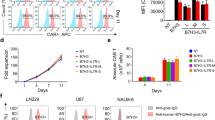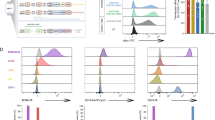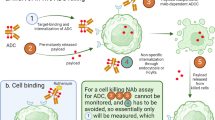Abstract
The overexpression of membrane-bound complement regulatory proteins (mCRP; CD46, CD55, CD59) preventing opsonization and complement-dependent cytotoxicity (CDC) is considered a major barrier for successful antibody-based cancer immunotherapy. To avoid a potential deleterious effect of mCRP neutralization on normal tissue cells, complement regulation has to be selectively targeted to the malignant cells. In this study, anti-mCRP small interfering RNAs (siRNAs) were encapsulated in transferrin-coupled lipoplexes for the specific delivery to transferrin receptor CD71high expressing BT474, DU145, and SW480 as well as corresponding CD71-knockdown (CD71low) tumor cells. Targeted delivery with transferrin-siRNA-lipoplexes became possible by charge neutralization and resulted in efficient silencing of all three mCRPs up to 90 %, which is dependent on their CD71 expression. The mCRP knockdown led to a significant increase of CDC on CD71high tumor cells by 68 % in BT474, 58 % in DU145, and 40 % in SW480 cells but only slightly increased on CD71low cells. Downregulation of CD46 and CD55 significantly increased C3 opsonization only on CD71high tumor cells. Our results demonstrate for the first time that by specific delivery of anti-mCRP siRNA through transferrin receptor, complement regulation can be selectively neutralized, allowing specific antibody-mediated killing of tumor cells without affecting healthy bystander cells, which appears to be a suited strategy to improve antibody-based cancer immunotherapy.




Similar content being viewed by others
References
Carroll MC (2004) The complement system in regulation of adaptive immunity. Nat Immunol 5:981–986
Walport MJ (2001) Complement. First of two parts. N Engl J Med 344:1058–1066
Ricklin D, Hajishengallis G, Yang K, Lambris JD (2010) Complement: a key system for immune surveillance and homeostasis. Nat Immunol 11:785–797
Gasque P, Morgan BP, Legoedec J, Chan P, Fontaine M (1996) Human skeletal myoblasts spontaneously activate allogeneic complement but are resistant to killing. J Immunol 156:3402–3411
Goldberger G, Arnaout MA, Aden D, Kay R, Rits M, Colten HR (1984) Biosynthesis and postsynthetic processing of human C3b/C4b inactivator (factor I) in three hepatoma cell lines. J Biol Chem 259:6492–6497
Jurianz K, Ziegler S, Donin N, Reiter Y, Fishelson Z, Kirschfink M (2001) K562 erythroleukemic cells are equipped with multiple mechanisms of resistance to lysis by complement. Int J Cancer J Int du Cancer 93:848–854
Li L, Spendlove I, Morgan J, Durrant LG (2001) CD55 is over-expressed in the tumour environment. Br J Cancer 84:80–86
Thomas A, Gasque P, Vaudry D, Gonzalez B, Fontaine M (2000) Expression of a complete and functional complement system by human neuronal cells in vitro. Int Immunol 12:1015–1023
Donin N, Jurianz K, Ziporen L, Schultz S, Kirschfink M, Fishelson Z (2003) Complement resistance of human carcinoma cells depends on membrane regulatory proteins, protein kinases and sialic acid. Clin Exp Immunol 131:254–263
Frade R (1999) Structure and functions of proteases which cleave human C3 and are expressed on normal or tumor human cells: some are involved in tumorigenic and metastatic properties of human melanoma cells. Immunopharmacology 42:39–45
Fishelson Z, Donin N, Zell S, Schultz S, Kirschfink M (2003) Obstacles to cancer immunotherapy: expression of membrane complement regulatory proteins (mCRPs) in tumors. Mol Immunol 40:109–123
Gorter A, Meri S (1999) Immune evasion of tumor cells using membrane-bound complement regulatory proteins. Immunol Today 20:576–582
Czuczman MS, Olejniczak S, Gowda A, Kotowski A, Binder A, Kaur H, Knight J, Starostik P, Deans J, Hernandez-Ilizaliturri FJ (2008) Acquirement of rituximab resistance in lymphoma cell lines is associated with both global CD20 gene and protein down-regulation regulated at the pretranscriptional and posttranscriptional levels. Clin Cancer Res Off J Am Assoc Cancer Res 14:1561–1570
Ge X, Wu L, Hu W, Fernandes S, Wang C, Li X, Brown JR, Qin X (2011) rILYd4, a human CD59 inhibitor, enhances complement-dependent cytotoxicity of ofatumumab against rituximab-resistant B-cell lymphoma cells and chronic lymphocytic leukemia. Clin Cancer Res Off J Am Assoc Cancer Res 17:6702–6711
Golay J, Lazzari M, Facchinetti V, Bernasconi S, Borleri G, Barbui T, Rambaldi A, Introna M (2001) CD20 levels determine the in vitro susceptibility to rituximab and complement of B-cell chronic lymphocytic leukemia: further regulation by CD55 and CD59. Blood 98:3383–3389
Macor P, Tripodo C, Zorzet S, Piovan E, Bossi F, Marzari R, Amadori A, Tedesco F (2007) In vivo targeting of human neutralizing antibodies against CD55 and CD59 to lymphoma cells increases the antitumor activity of rituximab. Cancer Res 67:10556–10563
Takei K, Yamazaki T, Sawada U, Ishizuka H, Aizawa S (2006) Analysis of changes in CD20, CD55, and CD59 expression on established rituximab-resistant B-lymphoma cell lines. Leuk Res 30:625–631
Zhao WP, Zhu B, Duan YZ, Chen ZT (2009) Neutralization of complement regulatory proteins CD55 and CD59 augments therapeutic effect of herceptin against lung carcinoma cells. Oncol Rep 21:1405–1411
Hu W, Ge X, You T, Xu T, Zhang J, Wu G, Peng Z, Chorev M, Aktas BH, Halperin JA, Brown JR, Qin X (2011) Human CD59 inhibitor sensitizes rituximab-resistant lymphoma cells to complement-mediated cytolysis. Cancer Res 71:2298–2307
Geis N, Zell S, Rutz R, Li W, Giese T, Mamidi S, Schultz S, Kirschfink M (2010) Inhibition of membrane complement inhibitor expression (CD46, CD55, CD59) by siRNA sensitizes tumor cells to complement attack in vitro. Curr Cancer Drug Targets 10:922–931
Mamidi S, Cinci M, Hasmann M, Fehring V, Kirschfink M (2013) Lipoplex mediated silencing of membrane regulators (CD46, CD55 and CD59) enhances complement-dependent anti-tumor activity of trastuzumab and pertuzumab. Molec Oncol 7:580–594
Zell S, Geis N, Rutz R, Schultz S, Giese T, Kirschfink M (2007) Down-regulation of CD55 and CD46 expression by anti-sense phosphorothioate oligonucleotides (S-ODNs) sensitizes tumour cells to complement attack. Clin Exp Immunol 150:576–584
Filleur S, Courtin A, Ait-Si-Ali S, Guglielmi J, Merle C, Harel-Bellan A, Clezardin P, Cabon F (2003) SiRNA-mediated inhibition of vascular endothelial growth factor severely limits tumor resistance to antiangiogenic thrombospondin-1 and slows tumor vascularization and growth. Cancer Res 63:3919–3922
Tolentino MJ, Brucker AJ, Fosnot J, Ying GS, Wu IH, Malik G, Wan S, Reich SJ (2004) Intravitreal injection of vascular endothelial growth factor small interfering RNA inhibits growth and leakage in a nonhuman primate, laser-induced model of choroidal neovascularization. Retina 24:132–138
Park JW, Benz CC, Martin FJ (2004) Future directions of liposome- and immunoliposome-based cancer therapeutics. Semin Oncol 31:196–205
Camp ER, Wang C, Little EC, Watson PM, Pirollo KF, Rait A, Cole DJ, Chang EH, Watson DK (2013) Transferrin receptor targeting nanomedicine delivering wild-type p53 gene sensitizes pancreatic cancer to gemcitabine therapy. Cancer Gene Ther 20:222–228
Cardoso AL, Simoes S, de Almeida LP, Plesnila N, Pedroso de Lima MC, Wagner E, Culmsee C (2008) Tf-lipoplexes for neuronal siRNA delivery: a promising system to mediate gene silencing in the CNS. J Cont Rel Off J Cont Rel Soc 132:113–123
Dufes C, Al Robaian M, Somani S (2013) Transferrin and the transferrin receptor for the targeted delivery of therapeutic agents to the brain and cancer cells. Ther Deliv 4:629–640
Li X, Ding L, Xu Y, Wang Y, Ping Q (2009) Targeted delivery of doxorubicin using stealth liposomes modified with transferrin. Int J Pharm 373:116–123
Liu Y, Tao J, Li Y, Yang J, Yu Y, Wang M, Xu X, Huang C, Huang W, Dong J, Li L, Liu J, Shen G, Tu Y (2009) Targeting hypoxia-inducible factor-1alpha with Tf-PEI-shRNA complex via transferrin receptor-mediated endocytosis inhibits melanoma growth. Molec Ther J Am Soc Gene Ther 17:269–277
Mendonca LS, Firmino F, Moreira JN, Pedroso de Lima MC, Simoes S (2010) Transferrin receptor-targeted liposomes encapsulating anti-BCR-ABL siRNA or asODN for chronic myeloid leukemia treatment. Bioconjug Chem 21:157–168
Santel A, Aleku M, Keil O, Endruschat J, Esche V, Fisch G, Dames S, Loffler K, Fechtner M, Arnold W, Giese K, Klippel A, Kaufmann J (2006) A novel siRNA-lipoplex technology for RNA interference in the mouse vascular endothelium. Gene Ther 13:1222–1234
Jurianz K, Maslak S, Garcia-Schuler H, Fishelson Z, Kirschfink M (1999) Neutralization of complement regulatory proteins augments lysis of breast carcinoma cells targeted with rhumAb anti-HER2. Immunopharmacology 42:209–218
Ben-Kasus T, Schechter B, Sela M, Yarden Y (2007) Cancer therapeutic antibodies come of age: targeting minimal residual disease. Molec Oncol 1:42–54
Gancz D, Fishelson Z (2009) Cancer resistance to complement-dependent cytotoxicity (CDC): problem-oriented research and development. Mol Immunol 46:2794–2800
Horl S, Banki Z, Huber G, Ejaz A, Mullauer B, Willenbacher E, Steurer M, Stoiber H (2013) Complement factor H-derived short consensus repeat 18-20 enhanced complement-dependent cytotoxicity of ofatumumab on chronic lymphocytic leukemia cells. Haematologica 98:1939–1947
Horl S, Banki Z, Huber G, Ejaz A, Windisch D, Muellauer B, Willenbacher E, Steurer M, Stoiber H (2013) Reduction of complement factor H binding to CLL cells improves the induction of rituximab-mediated complement-dependent cytotoxicity. Leukemia 27:2200–2208
Lindorfer MA, Beum PV, Taylor RP (2013) CD20 mAb-mediated complement dependent cytotoxicity of tumor cells is enhanced by blocking the action of factor I. Antibodies 2:598–616
Czauderna F, Fechtner M, Dames S, Aygun H, Klippel A, Pronk GJ, Giese K, Kaufmann J (2003) Structural variations and stabilising modifications of synthetic siRNAs in mammalian cells. Nucleic Acids Res 31:2705–2716
Judge AD, Bola G, Lee AC, MacLachlan I (2006) Design of noninflammatory synthetic siRNA mediating potent gene silencing in vivo. Molec Ther J Am Soc Gene Ther 13:494–505
Carbognani P, Rusca M, Romani A, Spaggiari L, Cattelani L, Solli P, Bobbio P (1996) Transferrin receptor expression in nonsmall cell lung cancer: histopathologic and clinical correlates. Cancer 78:178–179
Daniels TR, Delgado T, Rodriguez JA, Helguera G, Penichet ML (2006) The transferrin receptor part I: biology and targeting with cytotoxic antibodies for the treatment of cancer. Clin Immunol 121:144–158
Ryschich E, Huszty G, Knaebel HP, Hartel M, Buchler MW, Schmidt J (2004) Transferrin receptor is a marker of malignant phenotype in human pancreatic cancer and in neuroendocrine carcinoma of the pancreas. Eur J Cancer 40:1418–1422
Smilevska T, Stamatopoulos K, Samara M, Belessi C, Tsompanakou A, Paterakis G, Stavroyianni N, Athanasiadou I, Chiotoglou I, Hadzidimitriou A, Athanasiadou A, Douka V, Saloum R, Laoutaris N, Anagnostopoulos A, Fassas A, Stathakis N, Kollia P (2006) Transferrin receptor-1 and 2 expression in chronic lymphocytic leukemia. Leuk Res 30:183–189
Qing Y, Shuo W, Zhihua W, Huifen Z, Ping L, Lijiang L, Xiaorong Z, Liming C, Daiwen X, Yu H, Wei X, Min F, Zuohua F, Guanxin S (2006) The in vitro antitumor effect and in vivo tumor-specificity distribution of human-mouse chimeric antibody against transferrin receptor. Cancer Immunol Immunother CII 55:1111–1121
Gatter KC, Brown G, Trowbridge IS, Woolston RE, Mason DY (1983) Transferrin receptors in human tissues: their distribution and possible clinical relevance. J Clin Pathol 36:539–545
Brooks D, Taylor C, Dos Santos B, Linden H, Houghton A, Hecht TT, Kornfeld S, Taetle R (1995) Phase Ia trial of murine immunoglobulin A antitransferrin receptor antibody 42/6. Clin Cancer Res Off J Am Assoc Cancer Res 1:1259–1265
Tros De Ilarduya C, Bunuales M, Qian C, Duzgunes N (2006) Antitumoral activity of transferrin-lipoplexes carrying the IL-12 gene in the treatment of colon cancer. J Drug Target 14:527–535
Acknowledgments
The study was supported by the “BMBF BIODISC (0315503)” and the “Exzellenzinitiative, Innovationfonds Frontier Programme, University of Heidelberg,” and by the “Stiftung für Krebs–und Scharlachforschung Mannheim”.
Conflict of interest
The authors disclose no potential conflicts of interest.
Author information
Authors and Affiliations
Corresponding author
Rights and permissions
About this article
Cite this article
Cinci, M., Mamidi, S., Li, W. et al. Targeted delivery of siRNA using transferrin-coupled lipoplexes specifically sensitizes CD71 high expressing malignant cells to antibody-mediated complement attack. Targ Oncol 10, 405–413 (2015). https://doi.org/10.1007/s11523-014-0345-6
Received:
Accepted:
Published:
Issue Date:
DOI: https://doi.org/10.1007/s11523-014-0345-6




